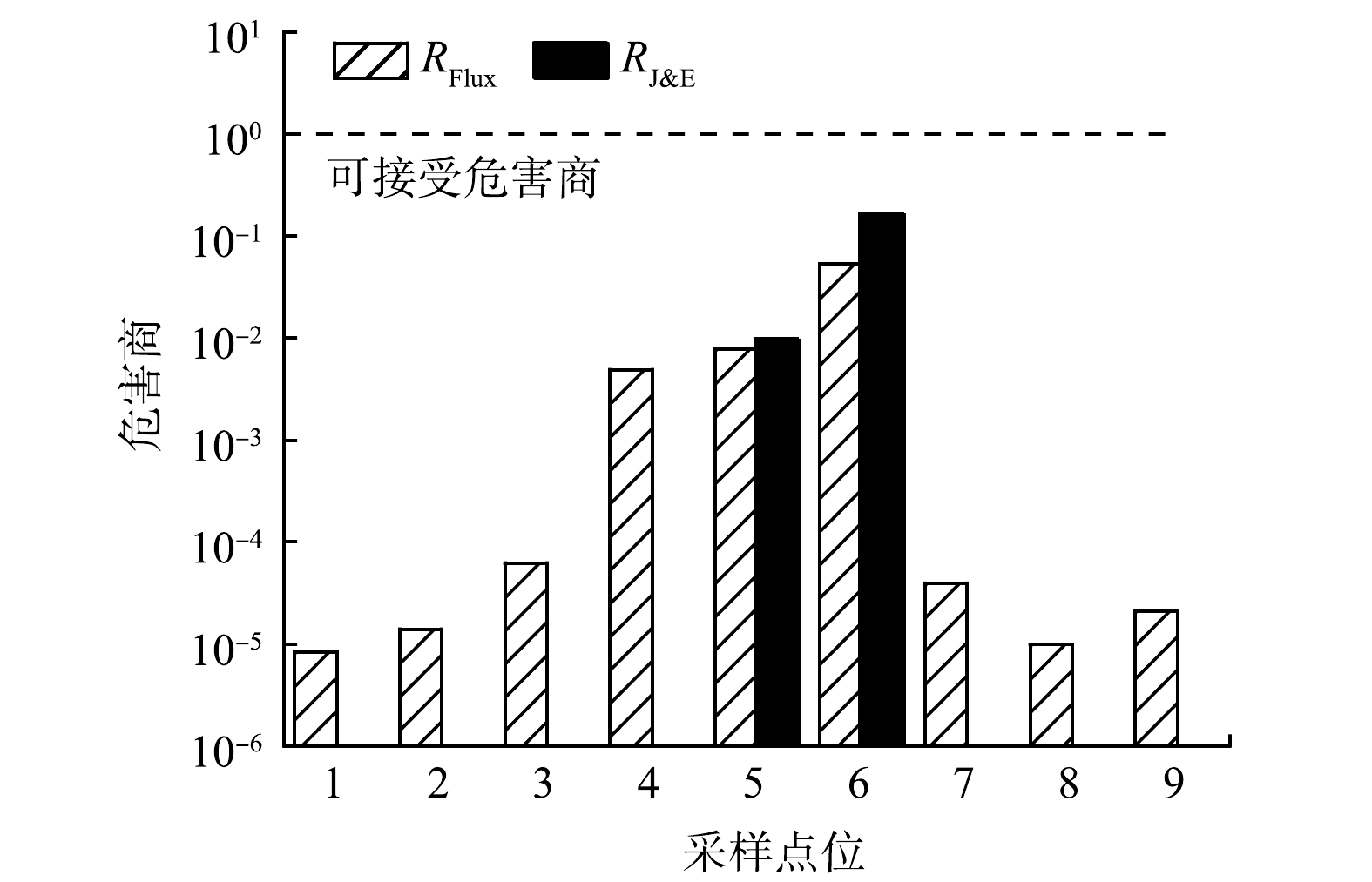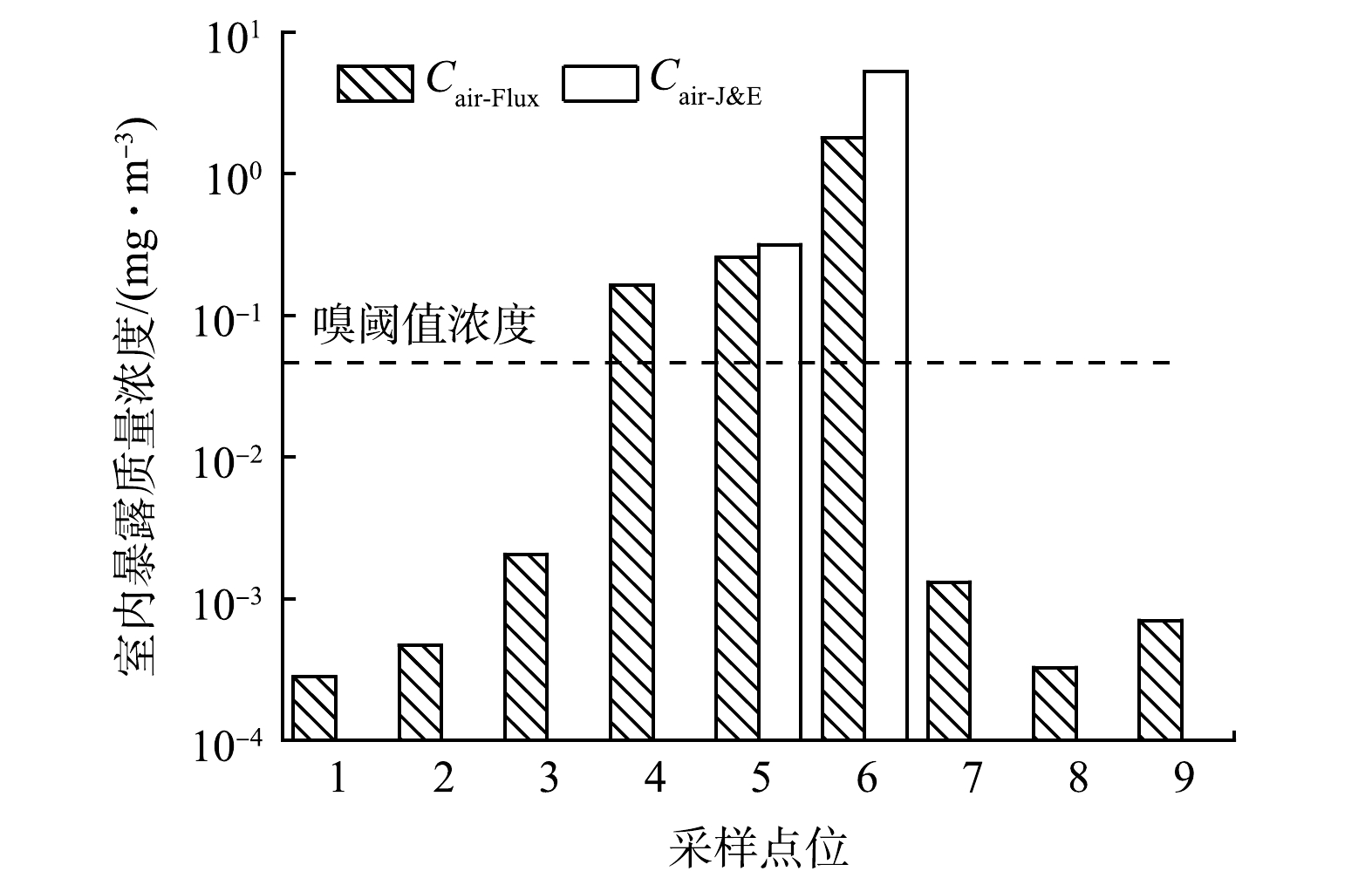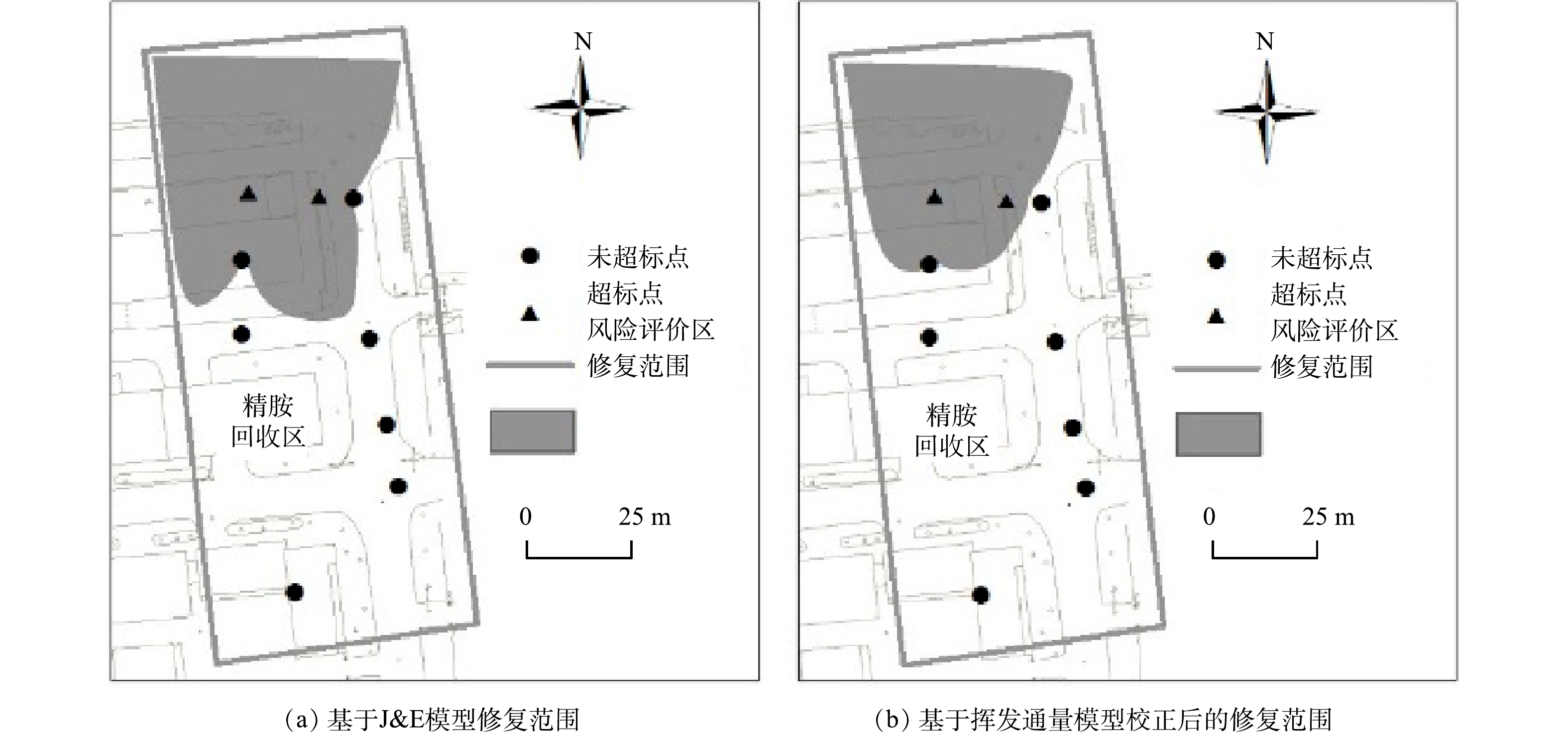-
我国现有的《建设用地土壤污染风险评估技术导则》 (HJ25.3-2019) (以下简称HJ25.3) [1]借鉴了美国国家科学院基于土壤中VOCs质量分数计算其呼吸暴露途径的健康风险评估方法,未考虑污染物对人体嗅觉感官的影响与刺激[2]。在实际应用中,当地块土壤中存在异味污染物时,即使健康风险可接受,仍会发生“异味扰民”现象[3]。马杰[4]在某农药污染地块调查中发现,地块土壤中污染物质量分数均低于《土壤环境质量 建设用地土壤污染风险管控标准 (试行) 》 (GB36600-2018) [5]筛选值,但仍散发出明显的刺激性气味。为控制污染地块中异味污染物的环境影响,提高居民生活质量,亟需开展针对异味污染物的风险评估与土壤修复目标值制定方法研究。
美国在污染地块风险评估过程中已关注异味污染物对人体嗅觉感官的影响[6]。2003年康涅狄格州发布的《修复标准法规 挥发标准》 (Remediation Standard Regulations Volatilization Criteria) [6]中将部分异味污染物的嗅阈值作为土壤污染物蒸气吸入暴露途径的室内空气质量浓度上限值。目前,国内已有学者开展了基于异味污染物嗅觉效应的土壤修复目标值 (或者土壤阈值) 制定方法研究。周友亚等[7]借助河北某化肥遗留场地,综合考虑氨氮对现场工作人员的嗅觉影响及健康风险评估结果,确定了土壤氨氮的风险控制值,并进一步上升为河北省地方标准《建设用地土壤污染风险筛选值》 (DB13T 5216-2020) [8]。张施阳等[9]以某退役污染地块为案例场地,构建了基于“异味土壤-挥发途径-嗅觉效应”的土壤苯系物异味评估方法,并利用污染地块长期和短期异味暴露效应模型,推导了地块苯系物土壤风险阈值。
我国污染场地相关导则推荐采用J&E模型进行呼吸暴露途径的风险评估,但J&E模型假定的VOCs在土壤气-固-液中的三相平衡分配理论忽略了土壤有机质等对污染物的吸附锁定效果,也未考虑向上迁移过程中的生物降解作用,故计算结果偏保守 [10-11]。针对这一问题,国内外许多研究机构开展了基于实测土壤气或土壤气挥发通量进行风险评估的研究工作。MCNEEL等[12]研究表明,基于土壤气挥发通量较之基于土壤中污染物质量分数采用J&E模型计算三氯乙烯与苯的健康风险低1~2个数量级。张蒙蒙等[13]基于土壤气挥发通量计算苯的健康风险相比基于土壤中污染物质量分数采用J&E模型计算的健康风险低1个数量级。李卫东等[14]采用挥发通量计算三氯甲烷的修复目标值高出基于J&E模型计算的修复目标值1个数量级。上述研究表明,基于实测土壤气或挥发通量进行健康风险评估并制定修复目标值,可在一定程度上规避J&E模型高估VOCs污染物实际风险造成过度修复的问题。但是,针对有恶臭气味的VOCs物质,如硫醚、氨氮等,不管是基于土壤中污染物质量分数还是基于土壤气和土壤气挥发通量,仅仅通过健康风险评估方法确定恶臭类VOCs土壤修复目标值难以保证不会发生“异味扰民”的舆情问题。
本研究以某农药污染地块二甲基二硫醚为研究对象,分别采集地块土壤和土壤气样品测定土壤二甲基二硫醚质量分数和土壤气挥发通量。基于J&E模型与土壤气挥发通量模型,以保护人体健康和防止异味扰民2个角度评价二甲基二硫醚的环境影响,并探索基于二甲基二硫醚嗅觉效应的土壤修复目标值的制定方法,以期为我国异味污染地块的环境管理提供参考。
-
项目地块位于长三角地区,占地面积约69 000 m2。原企业始建于1958年,主要从事农药与化工生产。地块于2007年停产搬迁后一直处于闲置状态,未来拟开发为仓储用地。地块污染状况调查过程中发现,土壤中存在二甲基二硫醚 (具有类似腐烂洋葱的恶臭气味) 污染。插值结果显示,地块东北侧原精胺回收车间所在区域土壤二甲基二硫醚质量分数较高 (图1) 。
-
根据地块污染状况调查过程中二甲基二硫醚插值结果 (图1) ,确定土壤中二甲基二硫醚质量分数较高且恶臭气味较重的原精胺回收车间为研究区域,在研究区域内选取地块污染状况调查过程中的异常点位附近2 m范围内分别布设9个土壤和土壤气挥发通量测试采样点 (图1) 。采用人工取土钻采集地表下1 m处柱状土样,使用非扰动采集器快速采集土壤样品,移至加有10 mL甲醇的棕色吹扫瓶内,参考《土壤和沉积物 挥发性有机物的测定 吹扫捕集/气相色谱-质谱法》 (HJ605-2011) 对样品进行定量分析[15]。土壤气挥发通量样品通过被动式采样器采集。被动式采样装置由575系列有机蒸气被动采样器 (内置活性炭) 和通量测试仪2个部分组成,如图2所示。被动式采样器固定于通量测试仪内部,安装于测试点7 d后取出,将其温度升到200 ℃后保持2 min,进样口初始温度230 ℃,离子源温度200 ℃,分流比为10:1;进样量为1 μL。
-
1) 基于嗅觉效应的评价模型与方法。土壤中的VOCs通过三相分配从土壤固相与液相进入土壤孔隙形成土壤气,经过垂向迁移扩散作用依次通过土壤非饱和带与边界滞留层到达建筑物底板,以对流或扩散的方式通过建筑物底板裂隙进入室内呼吸区后经呼吸暴露于人体[16]。当存在异味的VOCs污染物室内暴露质量浓度高于其嗅阈值时,会被人体嗅觉感官感知[17]。因此,确定异味VOCs污染物的室内暴露质量浓度是评价地块异味程度的关键。
基于土壤气挥发通量计算室内暴露质量浓度。土壤中的异味VOCs污染物到达室内呼吸区的3个过程中,土壤气挥发通量相等,满足通量连续性原则。因此,基于土壤气挥发通量的VOCs室内暴露质量浓度预测模型如式 (1)~式 (2) 所示[18]。
式中:
$ {C}_{\mathrm{a}\mathrm{i}\mathrm{r}-\mathrm{F}\mathrm{l}\mathrm{u}\mathrm{x}} $ 为基于土壤气挥发通量计算的室内暴露质量浓度,mg·m−3;Flux为测试点关注污染物的挥发通量,mg·m−2·s−1;M为通量测试仪内采样器中关注污染物通量测试期间吸附的污染物的质量,mg;LB为室内空间体积与气态污染物入渗面积比,m;ER为室内空气交换速率,次·s−1;A为被动式通量箱底面积,m2;T为通量测试持续时间,s。基于J&E模型计算室内暴露质量浓度。J&E模型假设土壤中的VOCs在固-气、液-气、液-固三相间处于动态、可逆的平衡过程,VOCs的土壤气质量浓度通过能斯特分布定律由土壤中污染物质量分数进行推算[19]。则土壤VOCs室内暴露质量浓度的J&E模型如式 (3)~式 (5) 所示。
式中:Cair-J&E为基于J&E模型计算的室内暴露质量浓度,mg·m−3;Cs为土壤中关注污染物质量分数,mg·kg−1;
$ {D}_{\mathrm{s}}^{\mathrm{e}\mathrm{f}\mathrm{f}} $ 为关注污染物在地基与墙体裂隙中的有效扩散系数,m2·s−1;H为亨利常数,无量纲;ρ为土壤容重,kg·dm−3;θwater为土壤中孔隙水体积比,无量纲;θair为土壤中孔隙空气体积比,无量纲;θt为土壤中总孔隙体积比,无量纲;η为地基裂缝表面积占室内地表面积比例,无量纲;θacrack为地基裂隙中空气体积比,无量纲;θwcrack为地基裂隙中水体积比,无量纲;Dair为空气中扩散系数,cm2·s−1;Dwater为水中扩散系数,cm2·s−1。2) 基于健康风险的评价模型与方法。二甲基二硫醚不属于国际癌症研究组织(IARC)中划分的5类致癌物,USEPA综合风险信息系统(IRIS)等国际权威毒理学数据库亦无二甲基二硫醚的非致癌效应毒理学数据[20]。参考USEPA《吸入参考剂量方法学》 (interim methods for development of inhalation reference doses) [21]获取二甲基二硫醚的未观察到有害作用水平 (NOAEL) ,外推二甲基二硫醚非致癌健康效应 (RfD) 模型如式 (6) 所示[22-23]。
式中:RfD为呼吸吸入参考剂量,mg·kg−1·d−1;UF为不确定系数,无量纲;MF为修正系数,无量纲;NOAEL为无可见有害作用水平,mg·kg−1·d−1。
①基于土壤气挥发通量计算危害商。结合式 (1) 与剂量-效应关系得到基于土壤气挥发通量的VOCs室内呼吸暴露途径危害商预测模型如式 (7) 所示。
式中:
$ {{R}}_{\mathrm{F}\mathrm{l}\mathrm{u}\mathrm{x}} $ 为基于土壤气挥发通量计算的危害商,无量纲;ED为暴露周期,a;EF为暴露频率,d·a−1;AT为非致癌效应平均时间,d;BW为成人体重,kg;DAIR为成人每日空气呼吸量,m3·d−1;。②基于J&E模型计算危害商。结合式 (3) 与剂量-效应关系得到基于J&E模型的室内呼吸暴露途径危害商预测模型如式 (8) 所示。
式中:
$ {{R}}_{\mathrm{J}\&\mathrm{E}} $ 为基于J&E模型计算的危害商,无量纲。 -
1) 基于嗅觉效应采用J&E模型计算二甲基二硫醚修复目标值。结合式 (3) ,可推导基于嗅觉效应采用J&E模型计算土壤修复目标值如式 (9) 所示。
式中:Cs-J&E为基于嗅觉效应采用J&E模型计算的土壤修复目标值,mg·kg−1;Codor为异味污染物嗅阈值,mg·m−3;Koc为土壤有机碳/土壤孔隙水分配系数,L·kg−1;foc为土壤有机碳质量分数,无量纲。
2) 基于嗅觉效应采用土壤气挥发通量计算二甲基二硫醚修复目标值。针对J&E模型计算的修复目标值相对较为保守的问题,可采用土壤气挥发通量对其进行校正。参考文献[14],采用基于实测土壤气挥发通量的评估模型与基于相应监测点位土壤中污染物质量分数的J&E模型分别计算室内呼吸暴露途径下的室内暴露质量浓度,计算2者的比值为模型校正因子。利用校正因子对基于J&E模型计算的土壤修复目标值进行校正,以获取更为客观的土壤修复目标值。模型校正因子计算如式 (10) 所示,获取模型校正因子后,参考式 (11) 对基于J&E模型计算的修复目标值进行校正。
式中:CF为模型校正因子,无量纲;Cs-Flux为基于实测土壤气挥发通量校正后的土壤修复目标值,mg·kg−1。
模型参数的取值与参考来源见表1。
-
如表2所示,土壤中有2个点位二甲基二硫醚高于检出限,其中,土壤中二甲基二硫醚最高检出质量分数 (7.64 mg·kg−1) 点位与土壤气挥发通量最大值 (0.001 24 mg·m−2·s−1) 点位一致;其他7个点位土壤中二甲基二硫醚质量分数均小于检出限 (0.1 mg·kg−1) ,而对应点位的土壤气中二甲基二硫醚均有不同程度的检出。这是因为,二甲基二硫醚挥发性较强,加之地块土壤有机碳质量分数相对较低 (foc = 0.002 9) ,使其更容易赋存于土壤气相中[29-31];同时,研究区表层0~4 m为孔隙较大、结构松散的杂填土层,为土壤气中二甲基二硫醚的扩散迁移提供了相对贯通的自由通道,故研究区域土壤气中二甲基二硫醚的分布相对均匀[32-33]。由此可见,采用土壤气测试结果来表征挥发性物质,尤其是有异味的挥发性物质的环境风险会更加客观实际。
-
1) 基于毒性效应的健康风险。采用《建设用地土壤污染风险评估技术导则》 (HJ25.3-2019) [1]推荐的J&E模型及基于土壤气挥发通量模型计算第二类用地暴露情境下室内挥发暴露途径二甲基二硫醚的非致癌危害商均低于1 (图3) ,表明地块土壤中二甲基二硫醚对人体健康风险可接受。
2) 基于嗅觉效应的环境风险。当二甲基二硫醚的室内暴露质量浓度超过嗅阈值时,异味污染物会被人体嗅觉感知,超过嗅阈值倍数越高异味越明显。通过土壤中二甲基二硫醚质量分数基于J&E模型计算点位5和6的室内暴露质量浓度均超过其嗅阈值 (0.046 mg·m−3),超标倍数分别为6.91与114.78倍;基于土壤气挥发通量计算的室内暴露质量浓度,在4、5与6号点位超过其嗅阈值,超标倍数分别为3.57、5.57与38.91倍 (图4) 。表明地块土壤存在异味环境风险。
综合图3与图4可看出,场地土壤二甲基二硫醚健康风险可接受,但由异味引起的环境风险不能忽视,基于嗅觉阈值制定土壤二甲基二硫醚的修复目标值可解决由异味引起的环境风险和扰民问题。
-
基于嗅觉效应采用2种模型计算二甲基二硫醚室内暴露质量浓度Cair-Flux和Cair-J&E,2者的95%置信区间上限分别为0.588与1.69 mg·m−3,模型校正因子为Cair-Flux和Cair-J&E的95%置信区间上限的比值,计算结果为0.348,如表3所示。其中土壤未检出点位二甲基二硫醚质量分数以检出限的1/2计算。
基于嗅觉效应采用模型校正因子对基于J&E模型计算的修复目标值进行校正 (表4) 。由表4可知,基于J&E模型计算的修复目标值为0.067 mg·kg−1,引入模型校正因子基于土壤气挥发通量的修复目标值为0.193 mg·kg−1,修复目标值相比J&E模型提高了一个数量级。这与姜林等[14]采用土壤气模型校正因子制定的修复目标值相比基于土壤中污染物质量分数的J&E模型提高了一个数量级的结论相符。采用ArcGIS软件对二甲基二硫醚污染土壤进行空间插值,如图5所示。由图5与表4可知,采用土壤气挥发通量校正后的修复土方量为16 362 m3,相比基于J&E模型的修复土方量减少了6 930 m3,约29.75%。可见,从嗅觉效应出发,在保证地块土壤既无健康风险,又无异味环境风险可安全利用的目标下,通过采用实测土壤气挥发通量校正因子CF校正后确定的二甲基二硫醚土壤修复目标值可在一定程度避免J&E模型过于保守的问题。
-
1) 二甲基二硫醚作为挥发性比较强的有机物更容易赋存于土壤气相中,采用土壤气测试结果来表征挥发性物质,尤其是有异味的挥发性物质的环境风险会更加客观可信。
2) 研究区域内二甲基二硫醚人体健康风险可接受,但室内暴露质量浓度超过污染物嗅阈值,最大超标倍数为114.78,存在异味环境风险。
3) 基于嗅觉效应采用实测土壤气挥发通量校正因子确定的二甲基二硫醚土壤修复目标值为0.193 mg·kg−1,相比基于土壤中二甲基二硫醚质量分数采用J&E模型的计算值提高了一个数量级,对应土壤修复方量减少约29.75%,可在一定程度上克服J&E模型过于保守的问题。
4) 目前我国污染地块环境管理体系主要基于人体健康风险,针对硫醚类等污染地块中常见的异味污染物,需要统筹考虑健康风险与嗅觉效应进行风险评估与土壤修复目标值的推导,可有效解决我国农药污染地块异味扰民的突出环境问题,为异味污染地块的环境管理提供技术支持。
基于嗅觉效应的土壤二甲基二硫醚修复目标值制定
Method of establishing soil remediation target value of dimethyl disulfide based on olfactory effect
-
摘要: 我国现行风险评估导则多采用基于土壤中污染物质量分数的Johnson-Ettinger(J&E)模型评估VOCs呼吸暴露健康风险,但对于土壤中异味污染物的特殊性考虑不足。以某农药污染地块土壤中异味污染物二甲基二硫醚为研究对象,分析了二甲基二硫醚在土壤与土壤气中的赋存状态,采用土壤气挥发通量与J&E模型分别计算室内呼吸暴露途径的健康与环境风险,探索基于异味污染物对人体嗅觉效应的土壤修复目标值制定方法。结果表明,土壤中二甲基二硫醚最高检出质量分数与土壤气挥发通量最大值检出点位一致,其余点位土壤气中二甲基二硫醚均有不同程度检出而土壤只有2个点位有检出;二甲基二硫醚作为挥发性比较强的有机物更容易赋存于土壤气相中,采用土壤气挥发通量测试结果来表征二甲基二硫醚的环境风险会更加客观可信。研究区域内二甲基二硫醚人体健康风险可接受,但室内暴露质量浓度最高值为5.28 mg·m−3,超过了污染物嗅阈值,存在异味引起的环境风险。基于嗅觉效应采用土壤气挥发通量制定的修复目标值为0.193 mg·kg−1,相比J&E模型提高了一个数量级,修复方量减少约29.75%。基于土壤气挥发通量综合考虑健康风险和嗅觉阈值进行风险评估与土壤修复目标值的制定,既能确保异味污染地块安全利用,又在一定程度上避免了过度修复的问题。本研究结果可为异味污染地块的环境管理提供参考。Abstract: The Johnson Ettinger (J&E) model based on soil pollutant mass fraction is mostly used to assess the health risk of inhalationexposure to VOCs of the current risk assessment guidelines in China. However, the specificity of odor pollutants in soil is narrowly considered. Herein, the health and environmental risks were calculated by the indoor inhalation exposure pathway via soil gas volatilization flux and J&E model. As an odor pollutant in soil of one pesticide contaminated site, dimethyl disulfide(DMDS) was chosen to explore and analyze occurrence conditions in soil and soil gas and the method of establishing the target of soil remediation due to the odour olfactory effect on humans. These results showed that the highest mass fraction of DMDS in soil were consistent with the highest detected level of soil gas volatilization flux at the same sampling point, and the remaining sampling points showed different degrees of detection of DMDS in soil gas without two points detected DMDS in soil. DMDS was more likely to be deposited in the soil gas phase and it would be more objective and reliable to the utilization of soil gas volatilization flux test results to characterize the environmental risk of DMDS. The human health risk of DMDS was acceptable in the investigation region, but the maximum indoor exposure concentration was 5.28 mg·m−3, which exceeded the odour threshold of pollutants, and there were environmental risks caused by odour. The remediation target value based on olfactory effect was 0.193 mg·kg−1, and the volatilization flux of soil gas exceeds the order of magnitude of J&E model, and the remediation cost could be reduced for around 29.75%. The risk assessment and soil remediation target value could improve the safe use of odour contaminated sites and block excessive remediation due to the soil gas volatilization flux integrated with the health risk and olfactory threshold. This research can provide advanced theoretical reference for the environmental management of odor contaminated sites.
-

-
表 1 模型参数定义及取值
Table 1. Definition and value of model parameters
参数 取值 单位 数据来源 参数 取值 单位 数据来源 LB 3 m HJ25.3[1] θt 0.42 无量纲 实测值 ER 1/4 320 次·s−1 HJ25.3[1] foc 0.002 9 无量纲 实测值 ED 25 a HJ25.3[1] A 0.054 2 m2 实测值 AT 9 125 d HJ25.3[1] T 604 800 s 实测值 θacrack 0.26 无量纲 HJ25.3[1] UF 1 无量纲 [21] θwcrack 0.12 无量纲 HJ25.3[1] MF 1 无量纲 [21] DAIR 14.5 m3·d−1 HJ25.3[1] H 0.044 5 无量纲 [24] η 0.000 5 无量纲 HJ25.3[1] Koc 220 L·kg−1 [25] EF 250 d·a−1 HJ25.3[1] Dair 0.096 cm2·s−1 [26] BW 61.8 kg HJ25.3[1] Dwater 1.26×10−5 cm2·s−1 [26] ρ 1.58 kg·dm−3 实测值 NOAEL 5.5 mg·kg−1·d−1 [27] θwater 0.3 无量纲 实测值 Codor 0.046 mg·m−3 [28] θair 0.12 无量纲 实测值 表 2 研究区域内各点位二甲基二硫醚质量分数
Table 2. Mass fraction of dimethyl disulfide at each point in the research region
采样点位 土壤中污染物
质量分数/ (mg·kg−1)土壤气挥发通量/
(mg·m−2·s−1)A1 ND 1.95×10-7 A2 ND 3.25×10-7 A3 ND 1.43×10-6 A4 ND 1.14×10-4 A5 0.46 1.78×10-4 A6 7.64 1.24×10-3 A7 ND 9.11×10-7 A8 ND 2.28×10-7 A9 ND 4.88×10-7 注:“ND”表示土壤中二甲基二硫醚未检出。 表 3 校正因子计算结果
Table 3. Correction factor calculation results
监测点 Cair-Flux/
(mg·m−3)Cair-J&E/
(mg·m−3)模型校正因子 1 2.81×10−4 3.45×10−2 $ {\rm{CF}}= \dfrac{{C}_{\mathrm{a}\mathrm{i}\mathrm{r}-\mathrm{F}\mathrm{l}\mathrm{u}\mathrm{x}}\text{ (}\text{95\%UCL}\text{) }}{{C}_{\mathrm{a}\mathrm{i}\mathrm{r}-\mathrm{J}\&\mathrm{E}}\text{(95\%UCL)}}= 0.348 $ 2 4.68×10−4 3.45×10−2 3 2.06×10−3 3.45×10−2 4 1.64×10−1 3.45×10−2 5 2.56×10−1 3.18×10−1 6 1.79×100 5.28×100 7 1.31×10−3 3.45×10−2 8 3.28×10−4 3.45×10−2 9 7.03×10−4 3.45×10−2 注:95% UCL表示 95%置信区间上限值。 表 4 基于嗅觉效应的修复目标值
Table 4. Remediation target value based on olfactory effect
计算模型 修复目标值/
(mg·kg−1)修复土方量/
m3基于Cs采用J&E模型 0.067 23 292 基于实测土壤气挥发通量
(校正因子)0.193 16 362 -
[1] 中华人民共和国生态环境部. 建设用地土壤污染风险评估技术导则: HJ25.3-2019 [S]. 北京: 中国环境科学出版社, 2019. [2] 周友亚, 姜林, 张超艳, 等. 我国污染地块风险评估发展历程概述[J]. 环境保护, 2019, 47(8): 34-38. [3] 王鑫. 农药厂原址地块楼盘建好后发现污染严重, 开发商称千余户已解约[EB/OL] . [2022-07-01]. https://www.thepaper.cn/newsDetail_forward_13574603. [4] 马杰. 我国挥发性有机污染地块调查评估中存在的问题及对策建议[J]. 环境工程学报, 2021, 15(1): 3-7. doi: 10.12030/j.cjee.202007080 [5] 中华人民共和国环境保护部. 土壤环境质量 建设用地土壤污染风险管控标准: GB36600-2018[S]. 北京: 中国环境科学出版社, 2018. [6] Connecticut Department of Environmental Protection. Connecticut’s Remediation Standard Regulations Volatilization Criteria[R]. America, 2003. [7] 周友亚. 污染场地土壤污染物修复目标值制定实践[EB/OL] . [2021-05-19].https://baijiahao.baidu.com/s?id=1667086023478546339. [8] 河北省生态环境厅. 建设用地土壤污染风险筛选值: DB13/T5216-2020 [S]. 北京: 中国环境科学出版社, 2020. [9] 张施阳, 吉敏, 李青青, 等. 基于嗅觉效应的土壤苯系物关键因子识别及安全阈值研究[J]. 环境科学学报, 2022, 42(8): 1-7. doi: 10.13671/j.hjkxxb.2021.0544 [10] ZHANG R H, JIANG L, ZHONG M S, et al. Applicability of soil concentration for VOC-contaminated site assessments explored using field data from the Beijing-Tianjin-Hebei urban agglomeration[J]. Environmental Science& Technology, 2019, 53(2): 789-797. [11] 姜林, 钟茂生, 夏天翔, 等. 基于土壤气中实测苯浓度的健康风险评价[J]. 环境科学研究, 2012, 25(6): 717-723. doi: 10.13198/j.res.2012.06.112.jiangl.010 [12] MCNEEL P J, DIBLEY V. Case study comparisons of vapor inhalation risk estimates: ASTM RBCA model prediction vs specific soil vapor data[R]. Washington DC: Law-rencen Livermore National Laboratory, 1997. [13] 张蒙蒙, 张超艳, 郭晓欣, 等. 焦化地块包气带区土壤苯的精细化风险评估[J]. 环境科学研究, 2021, 34(5): 1223-1230. [14] 姜林, 钟茂生, 梁竞, 等. 层次化健康风险评估方法在苯污染地块的应用及效益评估[J]. 环境科学, 2013, 34(3): 1034-1043. [15] 环境保护部. 土壤和沉积物挥发性有机物的测定 吹扫捕集/气相色谱-质谱法: HJ605—2011[S]. 北京: 中国环境科学出版社, 2011. [16] 李卫东, 张超艳, 郭晓欣, 等. 基于土壤气挥发通量的污染场地三氯甲烷健康风险评估[J]. 生态毒理学报, 2021, 16(1): 87-96. [17] 马妍, 郑红光, 史怡, 等. 典型农药污染地块土壤中异味物质的筛查与分布特征研究[J]. 环境科学研究, 35(6): 1482-1489. [18] 钟茂生, 赵莹, 姜林. 采用球形被动式采样器测定土壤气体挥发通量的方法: CN 106053288B[P]. 2018-11-30. [19] 张瑞环, 钟茂生, 姜林, 等. 基于DED模型的挥发性有机物健康风险评价[J]. 环境科学研究, 2018, 31(1): 170-178. doi: 10.13198/j.issn.1001-6929.2017.03.64 [20] US EPA. Integrated Risk Information System[EB/OL]. [2022.06. 24]. https://www.epa.gov/iris, [21] US EPA. Interim Methods for Development of Inhalation Reference Doses[S]. Washington DC: US EPA, 1989. [22] VANINDA E P, ABDUL R T, BACRUDIN L. Determination of dosage reference (RfD) of mercury based on NOAEL and characteristics of workers in the area of unlicensed gold mining (PETi) Maluku province indonesia[J]. Indian Journal of Public Health Research & Development, 2019, 10(9): 1207-1212. [23] 周忻, 刘存, 张爱茜, 等. 非致癌有机物水质基准的推导方法研究[J]. 环境保护科学, 2005(1): 20-22+26. doi: 10.3969/j.issn.1004-6216.2005.01.007 [24] United States National Library of Medicine. National center for biotechnology information [EB/OL]. [2022-07-30]. https://pubchem.ncbi.nlm.nih.gov/. [25] US EPA. Comp tox chemicals dashboard[EB/OL]. [2022-06-24]. https://comptox.epa.gov/dashboard/. [26] Water Pollution Control Federation. Operation of Municipal Water Treatment PlantsManual of Practice No. II, Vol. I: Chapter 3 Odor Control[M]. Water Pollution Control Federation, Alexandria, VA. 1990: 351-408. [27] API A M, BELSITO D, BISERTA S, et al. RIFM fragrance ingredient safety assessment, dimethyl disulfide, CAS Registry Number 624-92-0[J]. Food and chemical toxicology:an international journal published for the British Industrial Biological Research Association, 2021, 149(S1): 112122. [28] 王亘, 翟增秀, 耿静, 等. 40种典型恶臭物质嗅阈值测定[J]. 安全与环境学报, 2015, 15(6): 348-351. doi: 10.13637/j.issn.1009-6094.2015.06.072 [29] 罗晓丽, 齐亚超, 张承东, 等, 多环芳烃在中国两种典型土壤中的吸附和解吸行为研究[J]. 环境科学学报, 2008(7): 1375-1380. [30] LEE S, KOMMALAPATI R R, VALSARAJ K T, et al. Rate-limited desorption of volatile organic compounds from soils and implications for the remediation of a Louisiana superfund site[J]. Environmental Monitoring and Assessment, 2002, 75(1): 87-105. [31] MICHAEL O R, GARY P W, RACHEL A D, et al. Review of unsaturated-zone transport and attenuation of volatile organic compound (VOC) plumes leached from shallow source zones[J]. Journal of Contaminant Hydrology, 2011, 123(34): 130-156. [32] RUI S, KELLY G P, ERIC M S, et al. Influence of soil moisture on soil gas vapor concentration for vapor intrusion[J]. Environmental Engineering Science, 2013, 30(10): 628-637. doi: 10.1089/ees.2013.0133 [33] TODD M, WANG X M, ANDRE U, et al. Quantitative passive soil vapor sampling for VOCs. Part 1: theory[J]. Environmental Science Processes & Impacts, 2014, 16: 482-490. -




 下载:
下载:












